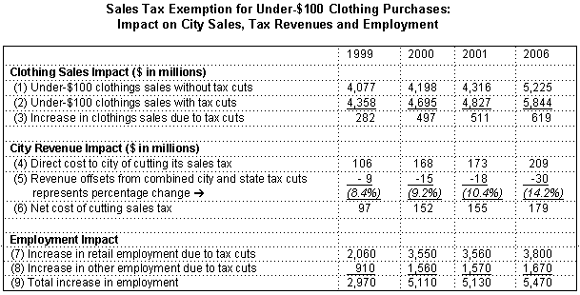
New York State recently enacted legislation phasing out the state’s 4.25 percent sales tax on purchases of clothing under-$100 and giving local governments the option of eliminating their own clothing sales taxes. With the necessary local legislation already enacted to eliminate New York City’s 4 percent tax, city shoppers can expect sales taxes on under-$100 clothing to be eliminated by December 1998.
In a recent study, IBO found that after a reduction in clothing sales taxes, apparel sales would be fueled both by money formerly spent on sales taxes and by additional sales shifted into the City as a result of decreasing the tax advantage currently enjoyed by New Jersey clothing retailers. IBO projects that once the tax cut on under-$100 clothing is fully phased-in, it will boost retail sales by over $500 million per year and create more than 5,000 new jobs—with over two-thirds of the jobs in the retail sector (see table below). However, given the fact that a good deal of the output and employment growth resulting from the increase in clothing sales would occur outside the city (where most of the clothing sold by city retailers is made), the fiscal benefits from this increase in sales is not as great as some have claimed.
IBO estimates that, even under generous assumptions, increases in economic activity attributable to the combined state and city elimination of sales taxes on under-$100 clothing will eventually generate just $30 million in city tax receipts each year, offsetting roughly 14 percent of the tax cut’s direct annual cost. For more information on retail sales tax cuts, see IBO’s June 1997 fiscal brief, Would Clothing Sales Tax Cuts Pay For Themselves?.
